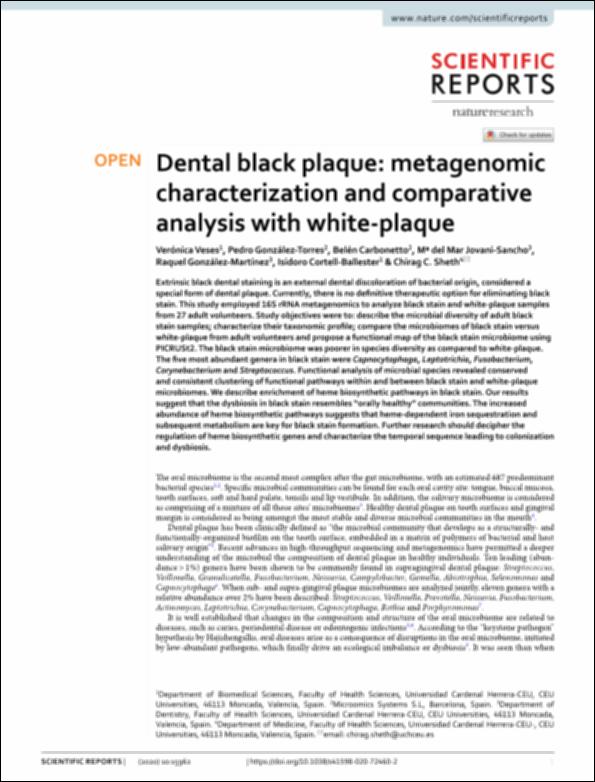Por favor, use este identificador para citar o enlazar este ítem:
http://hdl.handle.net/10637/11720Dental black plaque : metagenomic characterization and comparative analysis with white-plaque
| Título : | Dental black plaque : metagenomic characterization and comparative analysis with white-plaque |
| Autor : | Veses Jiménez, Verónica. González Torres, Pedro Carbonetto, Belén Jovani Sancho, María del Mar González Martínez, Raquel Cortell Ballester, Isidoro Sheth Shah, Chirag Chandrakant |
| Materias: | Dental plaque - Diseases.; Ecología microbiana.; Mouth - Microbiology.; Dientes - Bacteriología.; Placa dental - Enfermedades.; Microbial ecology. |
| Editorial : | Springer Nature. |
| Citación : | Veses, V., González-Torres, P., Carbonetto, B., Jovani-Sancho, MM., González-Martínez, R., Cortell-Ballester, I. et al. (2020). Dental black plaque: metagenomic characterization and comparative analysis with white-plaque. Scientific Reports, vol. 10, art. 15962. DOI: https://doi.org/10.1038/s41598-020-72460-2 |
| Resumen : | Extrinsic black dental staining is an external dental discoloration of bacterial origin, considered a special form of dental plaque. Currently, there is no definitive therapeutic option for eliminating black stain. This study employed 16S rRNA metagenomics to analyze black stain and white-plaque samples from 27 adult volunteers. Study objectives were to: describe the microbial diversity of adult black stain samples; characterize their taxonomic profile; compare the microbiomes of black stain versus white-plaque from adult volunteers and propose a functional map of the black stain microbiome using PICRUSt2. The black stain microbiome was poorer in species diversity as compared to white-plaque. The five most abundant genera in black stain were Capnocytophaga, Leptotrichia, Fusobacterium, Corynebacterium and Streptococcus. Functional analysis of microbial species revealed conserved and consistent clustering of functional pathways within and between black stain and white-plaque microbiomes. We describe enrichment of heme biosynthetic pathways in black stain. Our results suggest that the dysbiosis in black stain resembles “orally healthy” communities. The increased abundance of heme biosynthetic pathways suggests that heme-dependent iron sequestration and subsequent metabolism are key for black stain formation. Further research should decipher the regulation of heme biosynthetic genes and characterize the temporal sequence leading to colonization and dysbiosis. |
| Descripción : | Este artículo se encuentra disponible en la página web de la revista en la siguiente URL: https://www.nature.com/articles/s41598-020-72460-2 |
| URI : | http://hdl.handle.net/10637/11720 |
| Derechos: | http://creativecommons.org/licenses/by/4.0/deed.es |
| ISSN : | 2045-2322 (Electrónico) |
| Fecha de publicación : | 29-sep-2020 |
| Centro : | Universidad Cardenal Herrera-CEU |
| Aparece en las colecciones: | Dpto. Odontología |
Los ítems de DSpace están protegidos por copyright, con todos los derechos reservados, a menos que se indique lo contrario.


